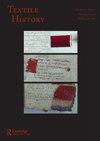Women’s Dress and the Demise of the Tailoring Monopoly: Farthingale-Makers, Body-Makers and the Changing Textile Marketplace of Seventeenth-Century London
IF 0.1
2区 社会学
0 HUMANITIES, MULTIDISCIPLINARY
引用次数: 3
Abstract
By 1700 tailors no longer dominated England’s garment marketplace, as stay-makers, mantua-makers and seamstresses now produced key items of female dress. The demise of the tailoring monopoly was a complex process involving many factors. This article examines an aspect of this transition that has been previously overlooked in histories of garment production: farthingale-makers and body-makers. These trades emerged at the start of the seventeenth century to make foundation garments that shaped the fashionable silhouettes of England’s women. This article presents a case study of the number, location, reputation and eventual demise of farthingale-makers and body-makers in the Drapers’ and Clothworkers’ Companies of London from 1600 to 1700. The story of these trades shows a growing diversification within garment-making during the seventeenth century, where both demand and opportunity allowed entrepreneurial tradesmen to break away from traditional systems of production, ultimately paving the way for the diverse textile marketplace of the eighteenth century.妇女服装和裁缝垄断的消亡:17世纪伦敦的法尔格制造商,身体制造商和不断变化的纺织品市场
到1700年,裁缝不再主导英国服装市场,因为现在,服装制造商、曼图亚制造商和裁缝都生产女性服装的关键产品。裁缝垄断的消亡是一个复杂的过程,涉及许多因素。这篇文章探讨了这种转变的一个方面,以前在服装生产史上被忽视了:法辛格尔制造商和身体制造商。这些行业出现在17世纪初,旨在制造塑造英国女性时尚轮廓的基础服装。本文对1600年至1700年间伦敦Drapers和Clothworkers公司的farthingale制造商和身体制造商的数量、地点、声誉和最终消亡进行了案例研究。这些行业的故事表明,在17世纪,服装制造业日益多样化,需求和机会都让创业商人摆脱了传统的生产体系,最终为18世纪多样化的纺织市场铺平了道路。
本文章由计算机程序翻译,如有差异,请以英文原文为准。
求助全文
约1分钟内获得全文
求助全文
来源期刊

TEXTILE HISTORY
HUMANITIES, MULTIDISCIPLINARY-
CiteScore
1.00
自引率
0.00%
发文量
0
期刊介绍:
Textile History is an internationally recognised, peer reviewed journal and one of the leading publications in its field. It is viewed as an important outlet for current research. Published in the spring and autumn of each year, its remit has always been to facilitate the publication of high-quality research and discussion in all aspects of scholarship arising from the history of textiles and dress. Since its foundation the scope of the journal has been substantially expanded to include articles dealing with aspects of the cultural and social history of apparel and textiles, as well as issues arising from the exhibition, preservation and interpretation of historic textiles or clothing.
 求助内容:
求助内容: 应助结果提醒方式:
应助结果提醒方式:


